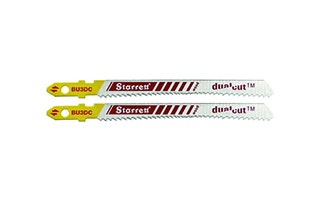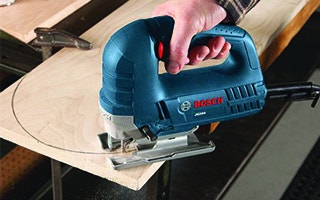Getting Good Jigsaw Cuts
Having trouble getting a uniform 90 degree cut from your jigsaw? It’s a common problem, especially when you’re cutting curves. The issue may lie with the blade, the saw, your technique or any combination of the three, as Michael Dresdner and Ellis Wallentine explain to this Woodworker’s Journal eZine reader:
Whenever I use the jig saw I find it difficult to keep the blade cutting ninety degrees to the base. The blade always seems to deflect. Is it the saw, my technique, or the blade?
Michael Dresdner: Could be any of the three. One way to test it is to set a heavy-duty wide blade into the saw (these blades, being more massive, deflect less), then check the angle between the blade and the base. Check it both at the top of its stroke, and at the bottom, to see if it is running true. (Naturally, do this with the tool off, and unplugged.) If the tool and blade read true, there is a good chance the problem lies with you.
Ellis Wallentine: All of the above may be at fault. Some blades are more flexible than others, although this is probably the least likely explanation. Other blades may be cheaply made and lead one way or the other because of uneven set to the teeth. More likely it is a combination of your technique and the saw you are using. It's important to develop a sense of touch with your saw so that you are not inadvertently bending the blade as you track around curves. Also if the saw has loose bearings and/or missing or inadequate blade guides, it will allow the blade to wander more than a tighter saw would.

The problem with jigsaw “technique” mentioned above stems from a tendency to push the saw laterally to either side, instead of straight into the cut, causing the blade to deflect in the opposite direction. The result is a cut that wanders in and out of square, leaving a wavy, distorted cut edge on the bottom side of the material. This happens most frequently when you’re cutting curves or trying to force the saw to move through the material faster than it wants to go. Slowing down and “steering” the saw, rather than forcing it onward as fast as it will go, will almost always yield a cut at a more consistent angle to the surface of the material. Still, no matter how delicate your touch with a jigsaw, some blades - and even some saws - just aren’t stable enough to reliably perform the simple task of cutting straight up and down. If a flimsy bargain blade with no backbone and inaccurately set teeth turns out to be the culprit, it’s an easy fix. Make the modest investment in a Starrett Woodworking Jig Saw Blades. Designed especially for cutting wood, Starrett uses a patent-pending technology to bond exceptionally hard, accurately set HSS teeth to a rigid backing material. The result is greatly reduced deflection and a fast, smooth cut that will register a “night and day” difference in anyone used to buying the cheapest blades on the rack.
If you’ve got the bugs worked out of your jig saw technique and you’re using a decent blade but still having trouble getting a good cut, the only thing left to consider is your saw. Most jigsaws have some sort of guide mechanism to help keep the blade on course. Some work better than others, however. A saw with no guide mechanism or one that’s poorly designed just can’t be relied upon for smooth, square cuts - especially in thicker or harder materials. If getting accurate jigsaw cuts on a consistent basic is important to you, you may have no choice but to buy a better saw. Happily, you have a few options.
Both the DeWalt DW318K and the Freud Heavy Duty Variable Speed Jig Saw have professional-class features including trigger-controlled speed, powerful motors, a sturdy left/right tilt base, and a roller blade guide mechanism placed near the work surface to limit blade deflection. At around $100, either would make an excellent entry point into the world of accurate jigsaw cutting. Moving up form there you’ll find the Bosch 1590 EVSK. Voted “best overall” in a 2006 Fine Homebuilding magazine comparison, the Bosch comes with everything you could ask for in a jigsaw, including a hefty 6.4 amp motor and its unique “Precision Control System” - a blade guide mechanism that offers near perfect blade stability. If you opt for one of these babies, outfit it with a Starrett blade (it comes with a few pretty good Bosch blades, too) and spend a little time practicing, you’ll be making cuts you’d be happy to get from a band saw before you know it.
Keep the inspiration coming!
Subscribe to our newsletter for more woodworking tips and tricks

